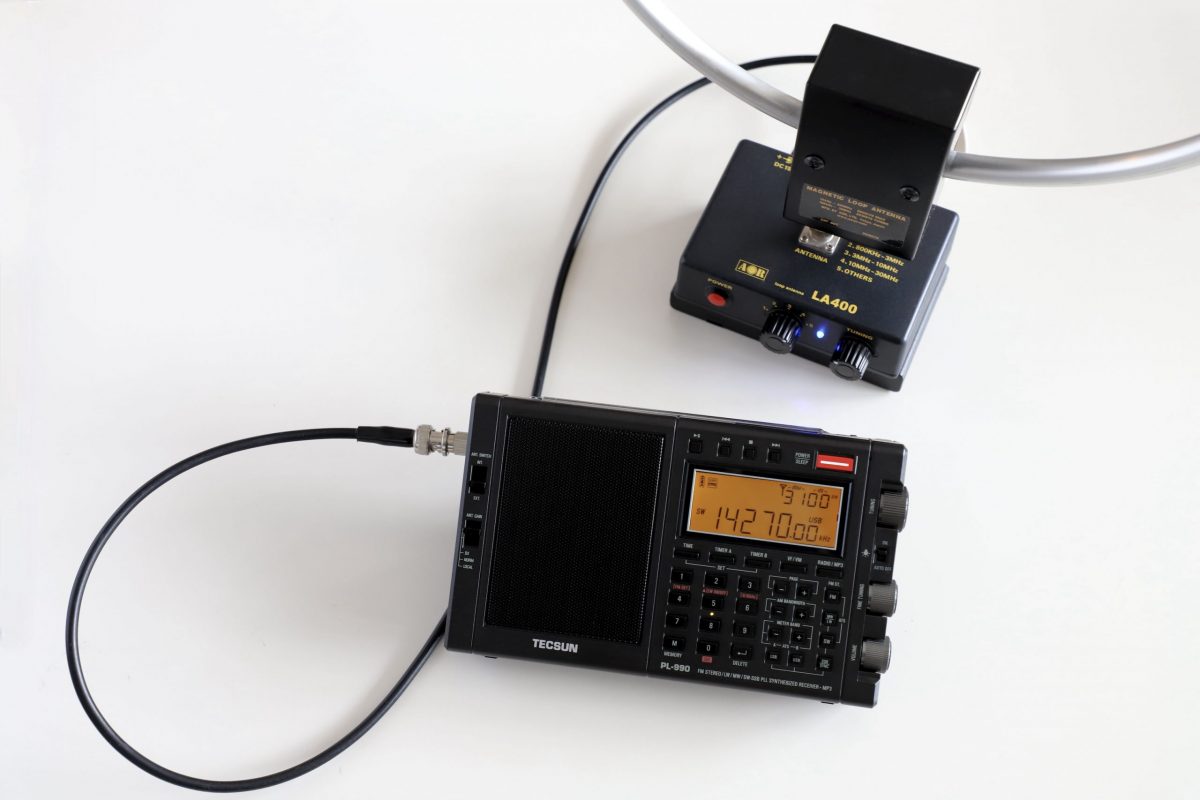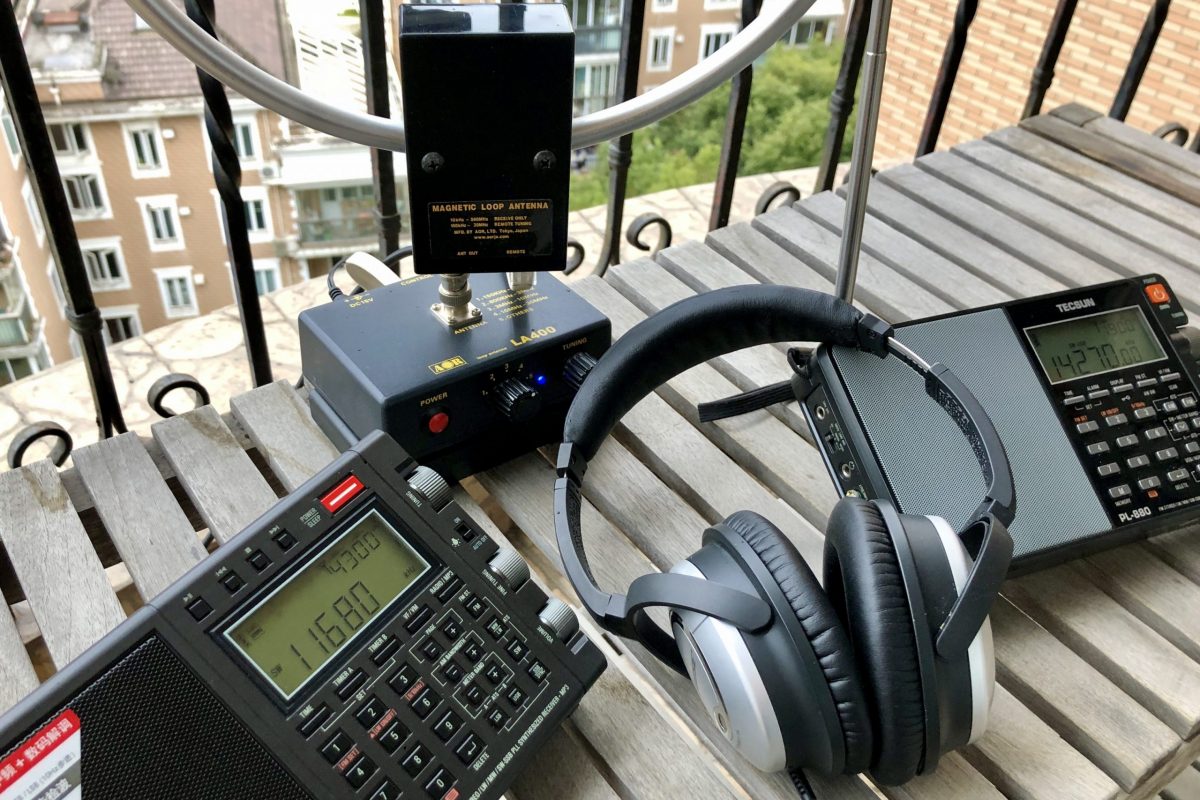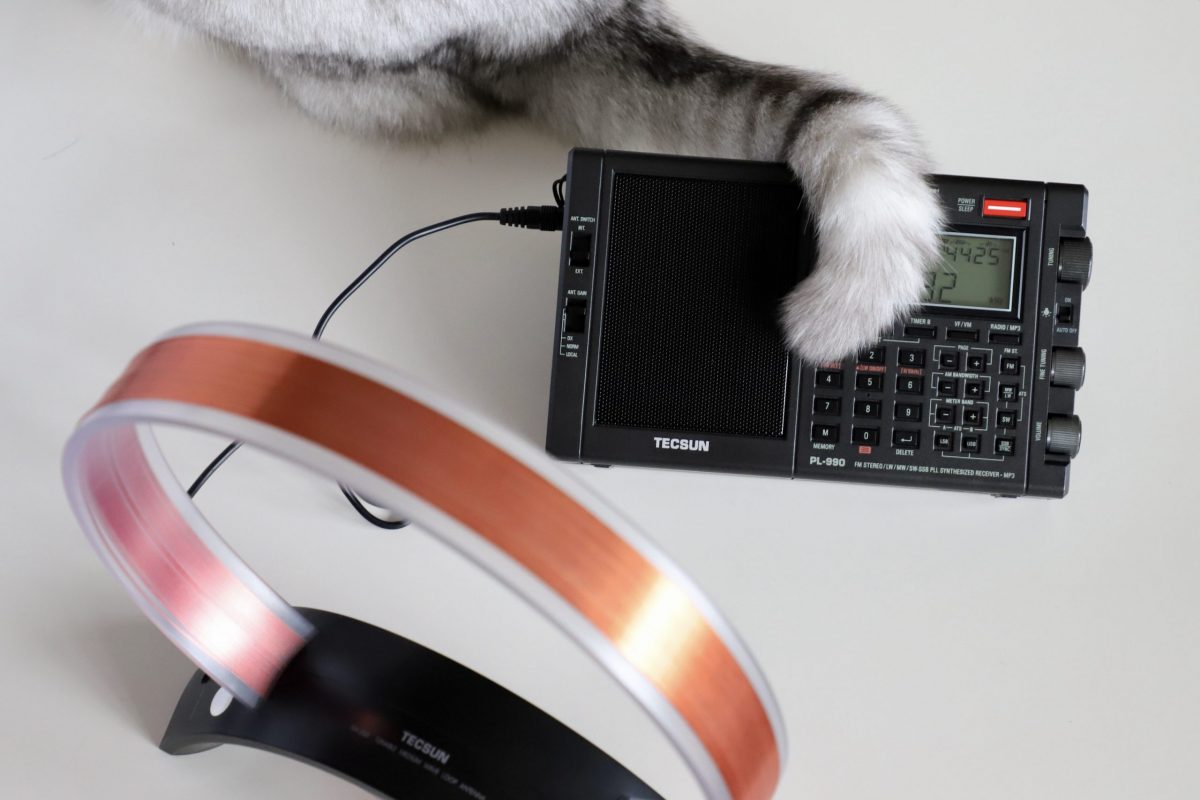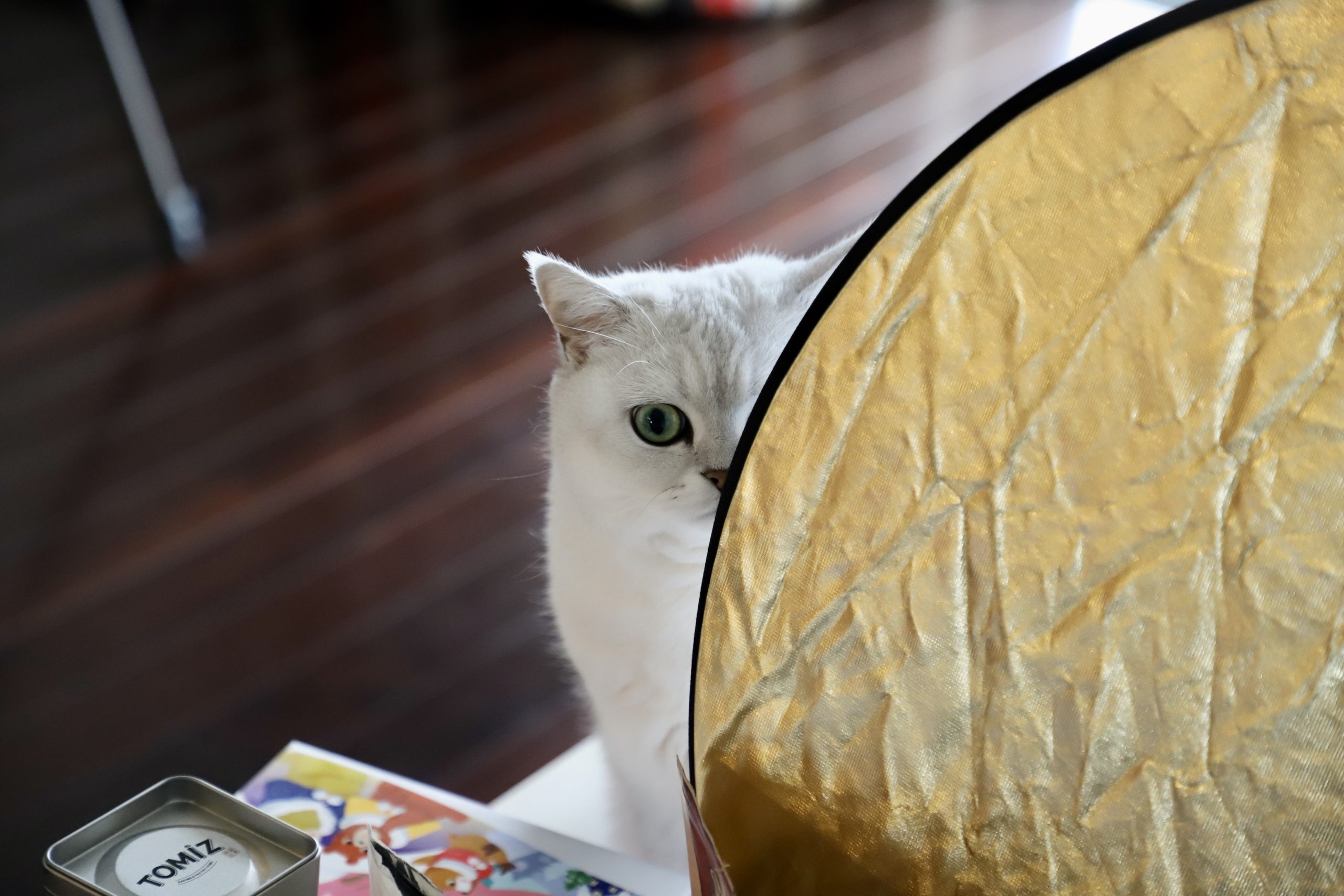Many thanks to SWLing Post contributor, Michael Ye (BD4AAQ), for the following guest post:
In the Loop: PL-990 and LA400, a Perfect Match
by Michael Ye (BD4AAQ)
I have been a happy owner of Tecsun’s PL-880 world band receivers for years. In fact I have two PL-880 radios, one sitting at home and the other staying in my car. So, after Tecsun introduced the new model PL-990 in late 2020, it didn’t take me long to decide to purchase one. In this article I will discuss the Tecsun PL-990 receiver working with loop antennas, while referencing some relevant features of the PL-880.
Overall performance of the PL-990
Merely by its model number, it is easy to regard the PL-990 as an upgraded version of the already highly reputable PL-880. As expected, the PL-990 can very much be regarded as a combination of all the existing fine radio features of the PL-880 AND the music and bluetooth additions, with a number of improvements for instance in shortwave and medium wave performance. The ergonomic design of the PL-990 looks and feels different from that of the PL-880 in a number of ways. Although I may prefer the the more slim and elegant appearance of the PL-880, the PL-990 gives a more rugged and durable feeling, among other improvements over the older PL-880.
Working with loop antennas
Living on the twelfth floor of a condominium in the crowded Shanghai, I have often been fascinated with loop antennas. As a licensed amateur operator, I have used the MFJ-1786X and have been impressed with its performance. On reception, I also find loop antennas appealing, as they are able to pull in weak signals while noticeably reducing electro-magnetic interference rampant in the urban environment. I have an unbranded shortwave loop antenna which I believe is based on and performs similarly with the AOR LA320. Despite its excellent performance, it is only good for the 5MHz – 15MHz shortwave range. So a few years ago when AOR launched the new LA400 wideband loop antenna, I bought one, which I often pair up with the PL-880 and other radios for shortwave listening, and get satisfactory results!
Antenna Switch on the PL-990
Now, back to the PL-990. When I first tried the PL-990 with the LA400, the results were generally good but not as good as as compared with using the same LA400 on my PL-880. This puzzled me for a day or so until I realised that the PL-990 actually has an antenna switch which the PL-880 does not have. The switch is used to toggle between an internal antenna (i.e. the built-in ferrite bar/telescopic antenna) and an external one (e.g. the AOR LA400). So a new PL-990 user who has often operated the PL-880 when first using the PL-990 could easily ignore the switch which should be pushed to “Ext” when plugging in an external antenna. This explains why the PL-990 may suddenly appear less sensitive than expected.
“Ext” antenna input for all bands
Contrary to the PL-880 whose external antenna socket is only good for shortwave signal input, the PL-990’s external antenna socket works with all bands, from long wave to FM. I found this to be an important and very useful change, and a pleasant surprise for my LA400, which covers a wide range of frequencies from long wave to medium wave to FM and up to 500MHz.
Once the LA400 is connected, the correct band selected, and last but not least the antenna switch turned to “Ext”, the PL-990 and the LA400 work like a charm in the indoor setting, remarkably better than the built-in telescopic antenna. With the loop connected, while there is not much to expect on the long wave band because of very few long wave stations remaining in the world, reception improves considerably on all other bands including on the medium wave and FM bands, as is also reflected on the upper right hand display of the signal strength and S/N ratio readings. Needless to say, performance on shortwave is as good as on the PL-880, if not better (again, remember to push the antenna switch to “Ext” when using it on the PL-990). Using the AOR loop on the PL-990 for FM reception is somewhat different as there does not seem to be a noticeable tuning point. Simply select the “Others” band, which appears to be broad enough for fair FM reception.
Tecsun AN-200 loop antenna
It is worth mentioning that I have a Tecsun AN-200 tunable medium wave antenna, which I have not used often. As its name suggests, it is for medium wave reception only. I tried it on the PL-990. Works great.
It is hard to tell which one, the PL-LA400 or the AN-200, fares better, as the signal strength and S/M readings are quite close. They both perform better than the radio’s internal ferrite bar antenna to varying degrees, by improving the signal strength or the S/N ratio or both. The Tecsun loop is a passive antenna, meaning no power is required, making it easy to be used “wirelessly”, by simply placing the loop close to the radio, without having to be connected to the radio via a cable.
It should be noted that in the “wireless” mode of the AN-200 the antenna switch on the PL-990 should remain at “Int” so as for its built-in ferrite bar and the loop to couple with each other.






One more question I have is what can I do to get better SW reception inside the house?
I’ve tried 7490 kHz inside the house, but can’t get it, it’s too garbled.
This is the post that said to tune in to 7490.
https://swling.com/blog/2021/02/ftiom-ubmp-february-14-20/
A loop antenna always helps. I use my LA400 indoor and get fairly good shortwave reception. However, your AN-200 is for MW only and so won’t help with SW reception. A simple method would be to connect a random wire with one end connected to the radio (via the antenna input socket or to or around its telescopic antenna) and then throw the other end of the wire out of the window.
Thanks. All of my windows have screens though, which can’t easily be removed. Or lifted.
Don’t break the window 😉 Placing the wire against your window glass (as close as possible) would still help.
For those unfamiliar with the concept of inductive coupling, it may be helpful to visualize the response fields of the AN-200 and internal ferrite loop. Visualize a response field in the shape of a doughnut having an infinitely small hole. Each antenna has its own doughnut, and moving them close together to the point where they effectively overlap causes them to interact with one another. Bear in mind, the ferrite loop in the radio does not stop receiving when inductive coupling is used. The air-core AN-200 has a somewhat larger doughnut, depending on its proximity and orientation with respect to the radio’s ferrite antenna, it will affect the response of the ferrite loop. In most positions, it will counter the field produced in the ferrite loop, and beyond this point, become the dominant magnetic field, i.e., signal, which arrives at the radio via the ferrite loop.
You can see where this very quickly becomes a complex physical interaction, again depending on the proximity and position of each antenna. Thus it is possible to create peaks and nulls of incoming signals, by repositioning the AN-200 or the radio. Ultimately, you can use this technique to tune two or more stations broadcasting on the same frequency.
The response of a loop antenna is defined as its “effective height,” and is calculated using a standard formula. The essential terms in the formula are the size of the loop, the permeability of the coil core, and orientation of the loop with respect to the incoming signal. The size of the loop is equal to the area of each turn of the coil times the number of turns. The core of the AN-200 is air, which has a permeability defined as 1, whereas ferrite used in many loop antennas has permeability around 125 times that of air. Bottom line: The effective height of the AN-200 coil (diameter x turns x 1) is somewhat greater than that of the ferrite loop (diameter x turns x 125). In addition, the AN-200 has a tuned circuit, which includes a series capacitor, and produces a much higher voltage when tuned to resonance. Most ferrite loops used in digital radios, on the other hand, are untuned, and simply transfer a broad band of long wave and medium wave signals to the RF amplifier.
Bob
I am not big into AM band DXing, but I have used the AN-200 as a coupler, especially for portable radios lacking an external antenna jack for mediumwave. I plug an external antenna like my 148′ loop-on-ground into the AN-200, then use the AN-200 to inductively couple the larger outdoor antenna to a radio’s internal ferrite loopstick antenna.
Even with the above configuration, the AN-200 typically still provides usable preselection/peaking via its tuning function as well. Naturally you lose the AN-200’s directivity by using it to couple a large horizontal loop, vertical, or fixed orientation antenna, but sometimes it is more about just getting a signal in the first place. 😉
From the pictures, it appears that the AN-200 is connected to the PL-990 using the supplied cable. I have never found this arrangement to be useful; i.e., the AN-200 has always performed better with it coupled inductively to the internal ferrite bar of the radio.
A few years ago, I dissected my AN-200 and found that the supplied cable connected to a 2-turn secondary coil located immediately under the primary coil. From my experience in building loop antennas, this close coupling has always resulted in overloading of the primary resonant circuit, which in turn lowers the Q, and consequently the gain provided by the resonant circuit. One source I have read advocated a secondary diameter ratio of 1/5 the primary diameter as providing the optimum transformer-style coupling. Without any supporting evidence, I have generally followed this over the years.
Bottom line: The design of the AN-200 secondary coil confounds me. It is obviously intended to be a low-impedance input to the radio. I have simply never been able to make it work. The AN-200, inductively coupled as described. is otherwise an effective, low-cost solution for DXing medium wave stations on a host of portable radios having internal ferrite antennas. Further, it does not involve any modifications.
Bob Colegrove
That’s interesting… I always wondered what’s the kicker with the AN-200. However that doesn’t apply in this specific case, as you can see on the other pic:s:, Lee De Furrest or Pawconi (not sure) is personally helping with reception by providing additional antenna elements. 🙂
Hello. I bought the Tecsun loop at about the same time I bought my S-2000 (the one with a fancy rotatable MW antenna). I connected the loop to the S-2000, but as you indicated, there was serious overloading and the “tuned” signal was even worse! I have since put it aside and have not used it much, although the induction solution does work for almost all MW radios. The PL-990, however, does not exhibit the same overloading issue with the loop connected. I don’t know much about the electronics or circuit inside but I suspect the PL-990 is different in some way, e.g. the antenna switch, to make the connected MW loop actually work. Cheers.
Will the AN-200 help with AM reception on the Tecsun PL-600?
What can I do to help with SW reception? Something easy to do.
Yes, it will help coupled inductively. Don’t use the cable as the external antenna jack on the PL-660 is for SW external antennas only. I have used the AN-200 with my PL-660 and Sony ICF-7600GR with good results on MW.
With the PL-990, you can connect directly by switching off the internal antenna. That is a good feature of the PL-990 compared to most portables.
Thank you for the response.
Where do I plug the AN-200 into then, on the PL-600?
FYI, one of my goals is to get better reception on an AM station about 120 miles away, inside the home.
I can kind of hear it, but it gets worse after 5 PM. After that, I have to strain to really hear it, and it’s a bit garbled as another radio station on a frequency 10 Khz away interferes.
Also, I notice that when my TV is on, then I get noticeably reduced reception on that radio station, as compared to when my TV is off.
So if I get this AN-200, do you think it will help with some of these conditions?
nuraman00:
You don’t physically couple them. The wire is not needed. Induction is done by placing the AN-200 right next to the PL-600. The internal ferrite bar antenna in the PL-600 will “induct” the signal received on the AN-200. You put them parallel to each other and adjust the control on the AN-200. You have to practice to get use to it. Just sit down at a table one night and move them around and see the different results you get. You’ll be amazed.
73 Don
I can tell you that my Tecsun AN-200 loop does improve AM reception of most stations on my PL-600. I actually lay the radio on its back inside the loop & turn the whole thing on a lazy susan to aim the antenna, preferably by a window facing the direction of the desired station.. Be sure to set the radio antenna gain switch to DX. Sunset & pre sunset listening can be challenging. Many TVs, especially plasma, will interfere with radio reception. Yes, the Tecsun AN-48 window SW antenna is good if you are unable to put up a 50 to 100 ft. random wire antenna. Good luck. 73s
Watch this video as it will show you how to use the An-200
https://www.youtube.com/watch?v=XS-wV9CKIJY
73, Don
Thanks for this video!
Nuraman,
Here is a YouTube demonstration of the AN-200 antenna using both inductive coupling and a direct feed of a capable radio using the plug-in cable which comes with the AN-200.
Note that the radio must have an external antenna connection which is useable on MW. Most are only useable on SW. Along with the PL-330, maybe the PL-990 external antenna port can be used on MW.
https://youtu.be/1VZAkDVPj_w
This was also a good video, thanks.
I bought, an-48x inside window x ant amp
Very good on sw my unit has triple conversation on sw